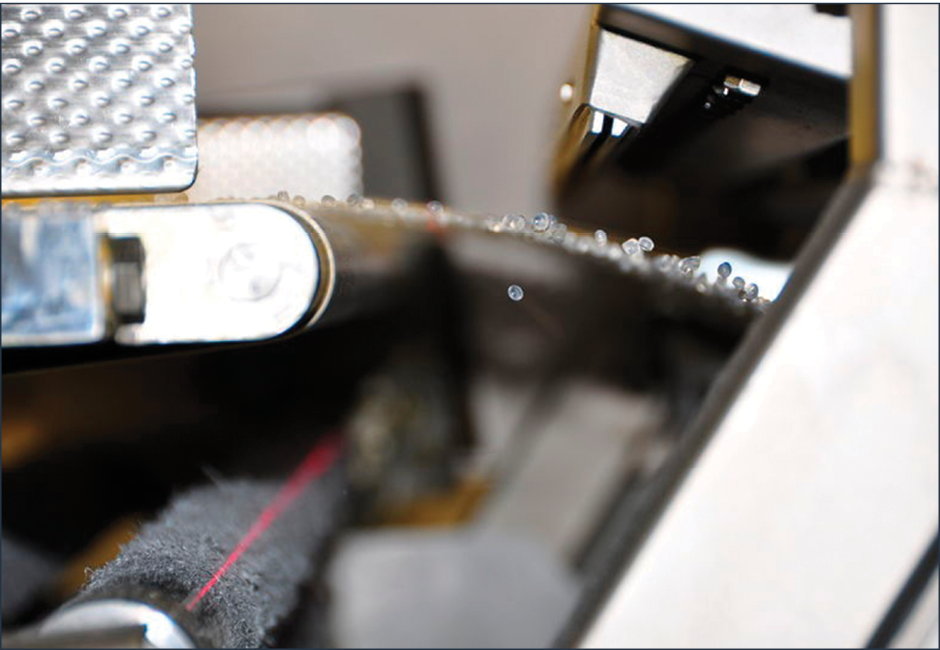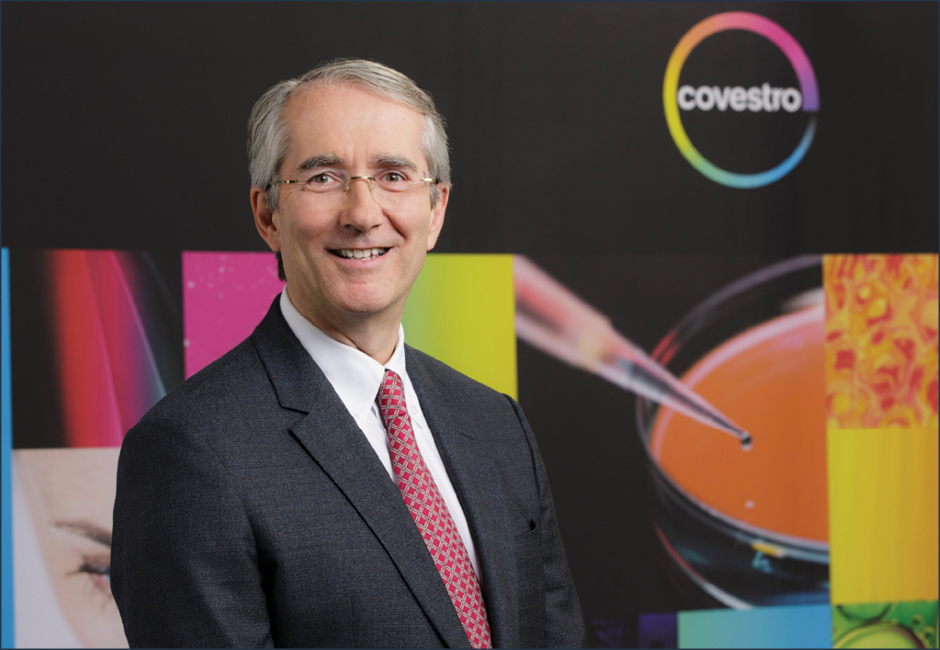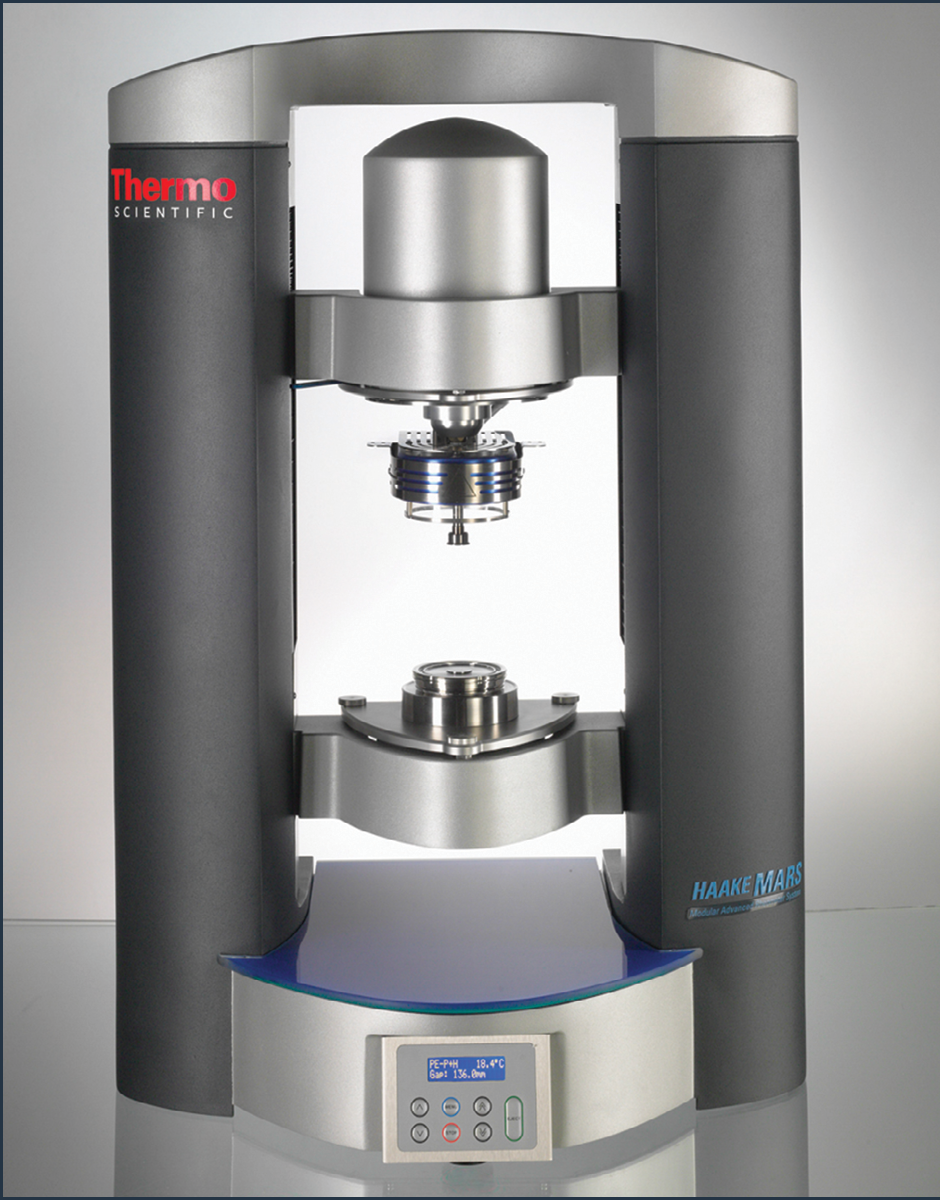
Photo courtesy of Tomra

Photo courtesy of Arburg

Patrick Thomas, Bayer MaterialScience

Photo courtesy of Thermo Scientific
High-tech optical separation of polymer pellets ensures pure and valuable material is consistently being introduced into the production cycle for further processing. Tomra Sorting Raw Materials manufactures what’s said to be the highest-capacity bulk-sorting equipment available in the plastics industry, achieving high resolution detection with high efficiency, while maintaining a superior yield.
Tomra’s Genius™ optical sorting machine sorts polymer and resin pellets based on color, structure, and shape, improving the quality of the end product by detecting and removing all kinds of defects and foreign material such as cross-contaminations, discolorations, black specks, light-yellows, dye drips, burn specks, twins, angel hair, and tails.
Johan Peeters, the company’s business development manager, explains: “At Tomra we sort a broad variety of polymer and resin pellets which are used in a widespread array of applications, such as wires and cables, automotive products, medical devices, and food packaging.
“Tomra’s Genius pellet sorter offers an advanced optical sorting solution combining different cutting-edge sensor technologies in a one-pass process. This process includes three major
sections that are the fundamental components of optical sorting: product handling, high resolution detection, and high accuracy ejection.
“It’s the combination of these essential elements that makes our design the ultimate optical sorter,” Peeters adds.
With high-resolution cameras and lasers, the sorter offers different inspection technologies in different inspection zones. For instance, RGB or color cameras focus on discolored pellets, while the double-sided high-resolution monochromatic cameras detect micron-scale specks in one pass. Detection capabilities are not limited to the visible spectrum, but also take advantage of infrared, ultraviolet, and other spectra. By using cameras which can be positioned at various angles, the user is given the advantage to scan the product from multiple sides.
In addition, Tomra has developed a unique optical feature which differentiates material with structural defects from in-spec product. The technology is based on multiple lasers, providing flexibility in sorting different types of products. It has proven to be far superior to other sorting methods, the company claims: “With unmatched speed, precision, and accuracy, it detects foreign bodies or defects with exactly the same color as the good product.”
Arburg’s U.S. subsidiary had two good reasons to celebrate in June 2015: Together with 245 customers and guests, the company marked the 25th anniversary of Arburg Inc. and also officially inaugurated the new premises for the U.S. headquarters in Rocky Hill, Connecticut.
As part of the opening ceremony, Michael Hehl, managing partner and spokesperson for the Arburg management team, offered congratulations on behalf of the entire parent company: “North America is Arburg’s largest foreign market, in which we have installed more than 12,000 machines. Our new headquarters in Rocky Hill represents a further milestone in our success story in the U.S.
“In addition to the Arburg Inc. subsidiary founded in the U.S. in 1990, we are also represented in North America with the Arburg Technology Centers in California (1993) and the Midwest (2007).” In this context, Michael Hehl expressed his thanks to the company’s customers for the trust they have placed in the family-run company and for the successful cooperation.
In recognition of the American team’s great commitment over the past 25 years, a commemorative sculpture and certificate were presented to Friedrich Kanz, managing director of Arburg Inc. “Our new U.S. headquarters, our infrastructure, and our highly motivated team of experts will enable us to further intensify our collaboration with our customers,” said Friedrich Kanz, adding: “We are perfectly positioned to enjoy another 25 successful years in the U.S.”
The new Arburg building covers a total floorspace of 2,500 m2 (27,000 ft2) and boasts state-of-the-art infrastructure. The centerpiece of the new building is the showroom, which has sufficient space for seven Allrounder injection molding machines that can be used for testing and training purposes. There’s also plenty of space for setting up and dismantling complete turnkey systems, which are experiencing rapid growth in demand in the USA.
The building also features a comprehensive spare parts store, a machine store, and a special area for the Freeformer, the additive manufacturing system that’s been available in the USA since its launch at the NPE trade fair in March 2015.
The seventeenth annual SPE TPO Automotive Engineered Polyolefins Conference®, the world’s leading automotive engineered polyolefins forum, will showcase talks by five keynote speakers from Ford Motor Co., Auto Harvest Foundation, Sumika Polymers North America, Asahi Kasei Plastics North America, and General Motors Co.
Throughout the conference, the keynotes will highlight important issues facing the automotive plastics market, including customer wants and needs, future automotive trends, the global outlook for automotive polyolefins, oil and shale gas impacts on vehicle lightweighting, and the evolution of TPO material performance. Organized by the Detroit Section of the Society of Plastics Engineers (SPE), the 2015 conference and exhibition returns to the Troy Marriott in the Detroit suburbs October 4-7, 2015.
On Monday the 5th, after brief remarks by conference co-chairs, the event will begin with a keynote titled “TPO: A Customer’s Perspective” by Michael Whitens, director, Vehicle & Enterprise Sciences at Ford Motor Co. “In my talk I’ll discuss what a customer, namely Ford Motor Co., wants and needs with regard to thermoplastic polyolefins (TPOs). I’ll cover some key improvements that have boosted performance and lowered cost over the past few decades, then describe areas where we’d like to see these materials improve as we move forward,” notes Whitens.
Immediately after Whitens, David Cole, chair, Auto Harvest Foundation, will give the second keynote of the morning titled “The Auto Future: Fast, Furious and Exciting.” “The auto industry has gone through an amazing transformation in the past few years,” explains Cole. “There are a number of concerns, however. There is still excess capacity at the global level, [and,] with re-expansion of the domestic market, there is a growing shortage of appropriately educated future employees, and that’s exacerbated by accelerated retirement of ‘Boomers.’ Furthermore, there are tough new regulations to meet, economic uncertainty across many of the world’s economies, and much more.”
On Tuesday the 6th, Brian K. Weider, president of Sumika Polymers North America, Inc., will lead off with a keynote on the topic of “Global Outlook for the Polyolefin and Automotive Businesses.” “I’ll start off by discussing long-term trends affecting polypropylene, polyethylene, and the elastomers supply base,” says Weider. “Then I’ll look at current trends in the automotive industry for TPOs and TPEs. Finally I’ll discuss some future trends we anticipate that will affect the entire global automotive resin market.”
That day will also feature a keynote from John Moyer, president and COO, Asahi Kasei Plastics North America. He’ll give a talk titled “Oil, Shale Gas, Fuel Efficiency, Lightweighting, & Other Funny Things that Happened on the Way to the TPO Forum.” “My talk will begin with a discussion of all the changes in the world of energy costs,” says Moyer. “I will also talk about compounders― both how we fit into this world of plastics and how we can change rapidly to meet the ever-changing world.”
And on Wednesday the 7th, the day will begin with a keynote from Matt Carroll, engineering group manager, General Motors Co., who will discuss “The Evolution of TPO Material Performance.” “The performance of thermoplastic polyolefins for both interior and exterior components has been scrutinized and steadily improved over the past 20 years,” states Carroll. “In this talk, I’ll review improvements in the performance of TPO over time and provide some personal thoughts about future usage and growth of this class of polymer in the automotive industry.”
Clariant announced the successful development of a glass-reinforced polyamide (nylon) with anti-static properties, low-temperature impact strength, dimensional stability, and excellent surface finish. It was created to help Advanced Design Concepts, Inc. (ADC), a custom molder, meet a customer’s need for housing electronic equipment that must operate safely in potentially explosive environments.
Mark Schaefer, founder and president of ADC, says his firm was asked to produce plastic housings that could meet requirements for certifications covering electronic gear used worldwide in areas with potentially explosive or flammable gases or vapors. Finding a supplier of materials that could meet the standards requirements was easy, Schaefer says, but finding one that could supply it in the necessary small quantities was more of a challenge. (His customer makes fewer than 1000 devices per year, so being able to get the resin in lots as small as 200 lb (90 kg) is a big advantage.)
ADC had been molding housings for non-hazardous applications previously, made from a glass-reinforced nylon 66. Clariant immediately came forward with a similar compounded material that incorporated the company’s permanent antistatic additive to meet the required surface resistivity specifications. The resin’s shrink rate was similar enough to the original material that ADC did not need to modify the molds, the company says.
Meeting the low-temperature impact requirements was another thing, however. After trying several other formulations, Clariant recommended a material originally developed for use in snowshoes. It’s a glass-filled nylon-6 material with the permanent antistatic additive. “I can tell that the material is not as stiff [as a standard-impact nylon],” Schaefer says, “but the average user wouldn’t even notice.”
Bayer announced that the new name of its MaterialScience business will be Covestro, effective on September 1, 2015. Bayer intends to float Covestro on the stock market by mid-2016 at the latest. The plan for Bayer MaterialScience to become a separate company was announced in September 2014.
“Covestro represents a bold new direction and bright future for an innovation-driven polymers company,” says Patrick Thomas, CEO of Bayer MaterialScience and CEO-designate of Covestro. “We are a company that is underpinned by strong and experienced management with a proven track record of excellence and full commitment to value creation. We have loyal and dedicated employees with whom we are confident we can build our future success,” he adds.
“We chose ‘Covestro’ because it reflects the exciting opportunity we will have to deploy our strengths even more rapidly, effectively, and flexibly in the global competitive arena,” explains Thomas. “The new name is part of a brand and identity that is the result of listening to our customers, employees, and others close to our business, and which reflects our innovation, talent, and big thinking. I am absolutely convinced that our colorful identity and positive vision will help inspire and motivate us on our new path to the future.”
Thomas adds that being separate will give the new company greater flexibility to independently pursue its business goals.
Manufacturing and design engineers thrive on producing new and innovative products, and rely on an efficient process to get them there. Now there are structural adhesives available to take that process to the next level.
3M‘s Scotch-Weld™ Acrylic Adhesive DP8425NS and Scotch-Weld™ Low Odor Acrylic Adhesive DP8825NS reportedly offer a faster cure time and expand process work time up to 25 minutes. The unique kinetics of the reaction accelerates the cure, reaching handling strength in 45 minutes and structural strength (1000 psi (6.9 MPa)) in 50 minutes, which means less clamp time.
The Scotch-Weld acrylic adhesives are designed to encourage manufacturing and design professionals to improve their processes and create projects that would otherwise be difficult to do with mechanical fasteners. “At 3M, we develop products that allow manufacturing engineers and design professionals to construct in ways that were never before possible,” says Mark DeLaForest, 3M marketing manager, Structural Adhesives. “With the expanded process time and improved performance of 3M Next Generation Acrylic Adhesives, we want to encourage those in the industry to produce beyond the limits of prior constraints.”
In addition to the extended process work time and fast cure time, the Scotch-Weld acrylic adhesives offer an 18-month shelf life and a higher impact resistance compared to conventional acrylic adhesives. Additionally, in order to improve workers’ environment and health, the adhesives are available in both a low-odor and non-flammable formula.
The company says the launch of the Scotch-Weld DP8425NS and Low Odor DP8825NS acrylic adhesives provides an opportunity for engineers and design professionals in a broad range of industries, including emergency transportation, electric sign manufacturing, satellite navigation, and architecture.
Material scientists in research and development, advanced quality control, and academic research can now use an enhanced, modular rheometer platform to increase workflow efficiency and minimize operator error while analyzing the rheological properties of a broad range of samples. The Thermo Scientific HAAKE MARS (Modular Advanced Rheometer System) 40 and 60 rheometers offer enhanced features to the existing line of accurate, user-friendly rheometers, allowing users to expand capabilities for future needs.
The rheometers are equipped with Connect Assist technology, first introduced with the Thermo Scientific HAAKE Viscotester iQ rheometer. Connect Assist automatically detects measuring geometry accessories and temperature modules to deliver real-time feedback, making it easy for users to set up sample testing procedures with minimal errors. A push-button, automatic geometry release system makes handling both simple and convenient.
“The newest generation of HAAKE MARS rheometers is focused on ease of use and a high level of customization, allowing lab managers to respond to their specific testing applications,” says Birgit Schroeder, product line director for laboratory instruments and material characterization products for Thermo Fisher Scientific.
The rheometers streamline workflows by offering application packages that bundle the rheometer with task-specific accessories for markets that include pharmaceutical, cosmetics, food, petrochemical, and polymers, the company adds.